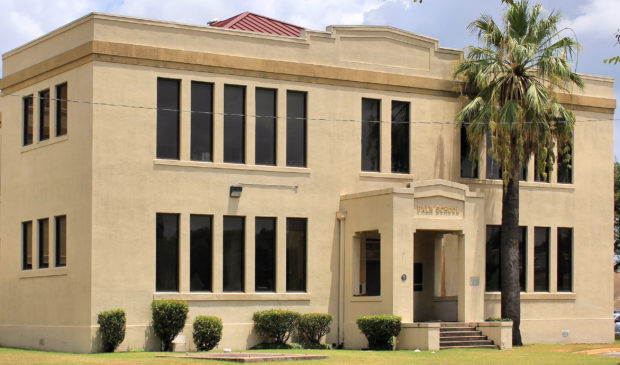Activists push to protect Palm School, eyeing property’s role in proposed cultural district
Thursday, February 20, 2020 by
Chad Swiatecki With Travis County moving ahead with action that could lead to development of the historic Palm School site downtown, local activists are hoping the city can find a way to preserve the property and make it a major part of a long-planned cultural and heritage district for the Mexican American community.
In December the city gave an update on the many steps involved in creating the district, which is seen as a way to strengthen and attract local businesses that could preserve the fast-disappearing Mexican American influence in the city’s core.
Direction on the proposed district was included as part of a larger Council action taken last spring. It would start at Fifth Street near Republic Square Park, continuing east to Interstate 35 or Plaza Saltillo, and extending south to Lady Bird Lake and the Rainey Street neighborhood.
Activist Paul Saldaña said the ongoing rift between the city and Travis County, which owns Palm School, make protecting the site the highest priority in the many steps needed to create the district.
“The city would also be interested in including the (district) in their formal response/proposal to the county for the Palm School property since it appears the county is moving forward with RFQ/RFP for the site,” he said via text. “Our community for the most part is already displaced so the Cultural Heritage District would simply formally acknowledge and hopefully become both a tourist and economic driver for Austin, i.e. creation of Mexican American Indigenous Museum, retail commerce space, and perhaps future home for Greater Austin Hispanic Chamber of Commerce.”
Because the city currently lacks a way to promote place-based economic development, the December memo notes that consulting firm QBL is analyzing the possible return on investment of the district, market conditions and any challenges, and how the city could go about codifying the district through ordinances or other actions.
The memo also details the city’s goals in developing an incentive program for developers in the proposed district to create favorable conditions for cultural and creative businesses in new building projects, with the 2018 Thriving in Place report a foundational piece of that work. Council action on those incentives is expected this spring or summer.
Other needed steps include building considerations into the new Land Development Code to promote cultural and creative uses, using applicable resources from the Souly Austin merchant association program, creating an overall plan for the district, and registering the district with the necessary state offices.
Community activist Martha Cotera said she and other supporters of the district concept want the city to revive the work initiated by former Council Member Mike Martinez, which sought to use tax incremental financing to capture tax revenue from increased property values that could be used to convert the Palm School site to a museum and expand the Emma S. Barrientos Mexican American Cultural Center.
Cotera said conversations with Council Member Kathie Tovo, whose district includes the proposed district, and Pio Renteria, who represents much of East Austin, have made her hopeful that property tax money currently directed to the General Fund could be redirected to the district.
“Everything in Austin takes time, and that’s OK because the more time you have the better you’re able to get buy-in from different groups. The to-do list for us is to identify the funds and get a firm commitment that they’ll be available because they were promised and they apparently went into the General Fund instead of where they were supposed to go,” she said. “The other priority is finalizing the acquisition of the Palm School property from Travis County so it can be preserved for use as a museum.”
Photo by Larry D. Moore [CC BY-SA 4.0], via Wikimedia Commons.
The Austin Monitor’s work is made possible by donations from the community. Though our reporting covers donors from time to time, we are careful to keep business and editorial efforts separate while maintaining transparency. A complete list of donors is available here, and our code of ethics is explained here.
You're a community leader
And we’re honored you look to us for serious, in-depth news. You know a strong community needs local and dedicated watchdog reporting. We’re here for you and that won’t change. Now will you take the powerful next step and support our nonprofit news organization?









